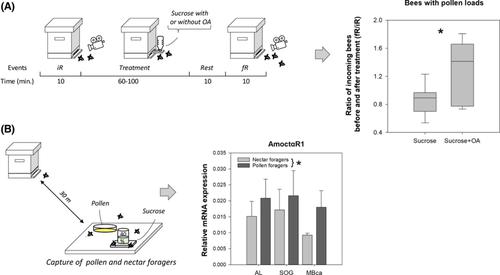当前位置:
X-MOL 学术
›
Genes Brain Behav.
›
论文详情
Our official English website, www.x-mol.net, welcomes your
feedback! (Note: you will need to create a separate account there.)
Correlation between octopaminergic signalling and foraging task specialisation in honeybees
Genes, Brain and Behavior ( IF 2.4 ) Pub Date : 2020-11-29 , DOI: 10.1111/gbb.12718 Andrés Arenas 1, 2 , Rocío Lajad 1, 2 , Tianfei Peng 3 , Christoph Grüter 3, 4 , Walter Farina 1, 2
Genes, Brain and Behavior ( IF 2.4 ) Pub Date : 2020-11-29 , DOI: 10.1111/gbb.12718 Andrés Arenas 1, 2 , Rocío Lajad 1, 2 , Tianfei Peng 3 , Christoph Grüter 3, 4 , Walter Farina 1, 2
Affiliation

|
Regulation of pollen and nectar foraging in honeybees is linked to differences in the sensitivity to the reward. Octopamine (OA) participates in the processing of reward‐related information in the bee brain, being a candidate to mediate and modulate the division of labour among pollen and nectar foragers. Here we tested the hypothesis that OA affects the resource preferences of foragers. We first investigated whether oral administration of OA is involved in the transition from nectar to pollen foraging. We quantified the percentage of OA‐treated bees that switched from a sucrose solution to a pollen feeder when the sugar concentration was decreased experimentally. We also evaluated if feeding the colonies sucrose solution containing OA increases the rate of bees collecting pollen. Finally, we quantified OA and tyramine (TYR) receptor genes expression of pollen and nectar foragers in different parts of the brain, as a putative mechanism that affects the decision‐making process regarding the resource type collected. Adding OA in the food modified the probability that foragers switch from nectar to pollen collection. The proportion of pollen foragers also increased after feeding colonies with OA‐containing food. Furthermore, the expression level of the AmoctαR1 was upregulated in foragers arriving at pollen sources compared with those arriving at sugar‐water feeders. Using age‐matched pollen and nectar foragers that returned to the hive, we detected an upregulated expression of a TYR receptor gene in the suboesophageal ganglia. These findings support our prediction that OA signalling affects the decision in honeybee foragers to collect pollen or nectar.
中文翻译:

章鱼胺能信号与蜜蜂觅食任务专业化的相关性
蜜蜂对花粉和花蜜觅食的调节与对奖励的敏感性差异有关。章鱼胺 (OA) 参与蜜蜂大脑中奖励相关信息的处理,是调解和调节花粉和花蜜觅食者之间分工的候选者。在这里,我们检验了 OA 影响觅食者资源偏好的假设。我们首先研究了口服 OA 是否参与从花蜜到花粉觅食的转变。我们量化了当糖浓度实验性降低时,经 OA 处理的蜜蜂从蔗糖溶液转换为花粉喂食器的百分比。我们还评估了喂食含有 OA 的菌落蔗糖溶液是否会增加蜜蜂收集花粉的速度。最后,我们量化了花粉和花蜜采集者在大脑不同部位的 OA 和酪胺 (TYR) 受体基因表达,作为影响有关收集资源类型的决策过程的推定机制。在食物中添加 OA 改变了觅食者从花蜜转向花粉收集的概率。用含 OA 的食物喂养菌落后,花粉觅食者的比例也增加了。此外,表达水平与到达糖水喂食器的觅食者相比,到达花粉源的觅食者中AmoctαR1上调。使用返回蜂巢的年龄匹配的花粉和花蜜采集器,我们检测到食管下神经节中 TYR 受体基因的表达上调。这些发现支持我们的预测,即 OA 信号会影响蜜蜂觅食者收集花粉或花蜜的决定。
更新日期:2020-11-29
中文翻译:

章鱼胺能信号与蜜蜂觅食任务专业化的相关性
蜜蜂对花粉和花蜜觅食的调节与对奖励的敏感性差异有关。章鱼胺 (OA) 参与蜜蜂大脑中奖励相关信息的处理,是调解和调节花粉和花蜜觅食者之间分工的候选者。在这里,我们检验了 OA 影响觅食者资源偏好的假设。我们首先研究了口服 OA 是否参与从花蜜到花粉觅食的转变。我们量化了当糖浓度实验性降低时,经 OA 处理的蜜蜂从蔗糖溶液转换为花粉喂食器的百分比。我们还评估了喂食含有 OA 的菌落蔗糖溶液是否会增加蜜蜂收集花粉的速度。最后,我们量化了花粉和花蜜采集者在大脑不同部位的 OA 和酪胺 (TYR) 受体基因表达,作为影响有关收集资源类型的决策过程的推定机制。在食物中添加 OA 改变了觅食者从花蜜转向花粉收集的概率。用含 OA 的食物喂养菌落后,花粉觅食者的比例也增加了。此外,表达水平与到达糖水喂食器的觅食者相比,到达花粉源的觅食者中AmoctαR1上调。使用返回蜂巢的年龄匹配的花粉和花蜜采集器,我们检测到食管下神经节中 TYR 受体基因的表达上调。这些发现支持我们的预测,即 OA 信号会影响蜜蜂觅食者收集花粉或花蜜的决定。











































 京公网安备 11010802027423号
京公网安备 11010802027423号